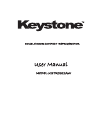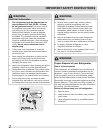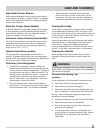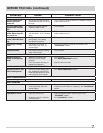
6
PROBLEM CAUSE CORRECTION
REFRIGERATOR OPERATION
Refrigerator does not
run.
Refrigerator is plugged into a •
circuit that has a ground fault
interrupt.
Temperature control is in the •
OFF position.
Refrigerator may not be •
plugged in, or plug may be
loose.
House fuse blown or tripped •
circuit breaker.
Power outage.•
Use another circuit. If you are unsure about the outlet, •
have it checked by a certified technician.
See • Setting the Temperature Control section.
Ensure plug is tightly pushed into outlet.•
Check/replace fuse with a 15 amp time-delay fuse. Reset•
circuit breaker.
Check house lights. Call local Electric Company.•
Refrigerator runs too
much or too long.
Room or outside weather is •
hot.
Refrigerator has recently been •
disconnected for a period of
time.
Large amounts of warm or hot •
food has been stored recently.
Door is opened too frequently •
or too long.
Refrigerator door may be •
slightly open.
Temperature control is set too •
low.
Refrigerator gasket is dirty, •
worn, cracked, or poorly fitted.
It’s normal for the Refrigerator to work harder under these •
conditions.
It takes 4 hours for the Refrigerator to cool down •
completely.
Warm food will cause Refrigerator to run more until the •
desired temperature is reached.
Warm air entering the Refrigerator causes it to run more. •
Open doors less often.
See • “DOOR PROBLEMS” section.
Turn control knob to a warmer setting. Allow several hours •
for the temperature to stabilize.
Clean or change gasket. Leaks in the door seal will cause •
Refrigerator to run longer in order to maintain desired
temperature.
Interior Refrigerator
temperature is too
cold.
Temperature control is set too •
low.
Turn the control to a warmer setting. Allow several hours •
for the temperature to stabilize.
Interior Refrigerator
temperature is too
warm.
Temperature contril is set too •
warm.
Door is opened too frequently •
or too long.
Door may not be seating •
properly.
Large amounts of warm or hot •
food has been stored recently.
Refrigerator has recently been •
disconnected for a period of
time.
Turn control to a colder setting. Allow several hours for the •
temperature to stabilize.
Warm air entering the Refrigerator causes it to run more. •
Open doors less often.
See • “DOOR PROBLEMS” section.
Warm food will cause Refrigerator to run more until the •
desired temperature is reached.
It takes 4 hours for the Refrigerator to cool down •
completely.
Refrigerator external
surface temperature is
warm.
The external Refrigerator walls •
can be as much as 30°F warm-
er than room temperature.
This is normal while the compressor works to transfer heat •
from inside the Refrigerator cabinet.
SOUND AND NOISE
Louder sound levels
when Refrigerator is
on.
Modern• refrigerators have
increased storage capacity and
more stable temperatures.
They require a high efficiency
compressor
This is normal. When the surrounding noise level is low, •
you might hear the compressor running while it cools the
interior.
BEFORE YOU CALL











